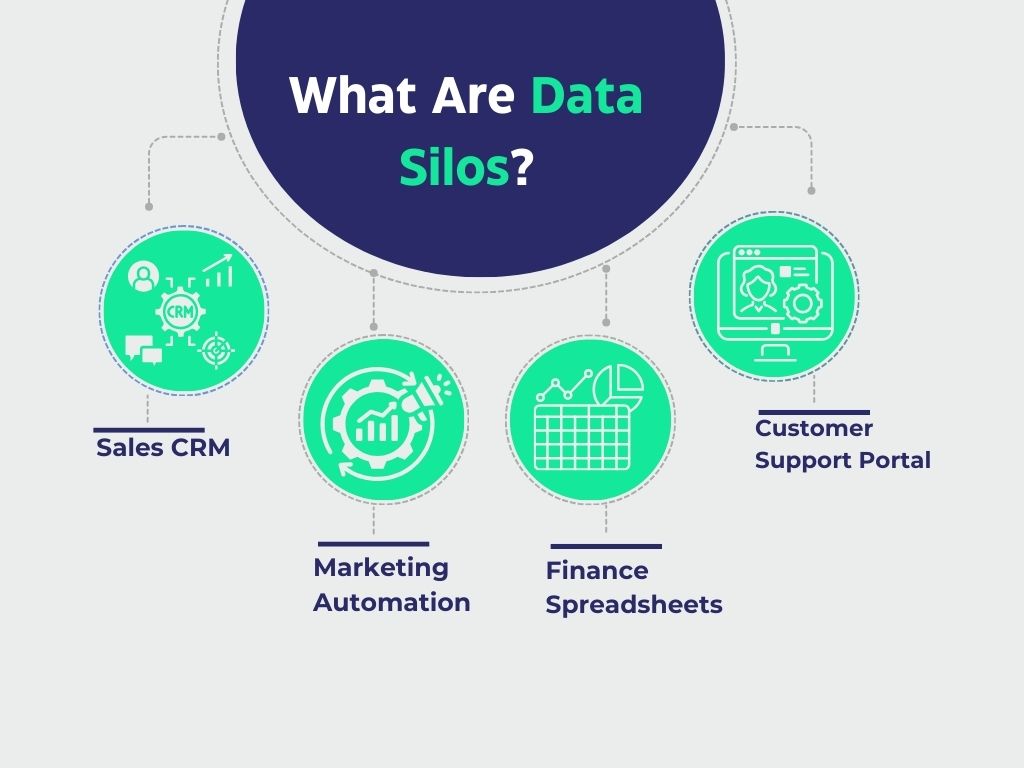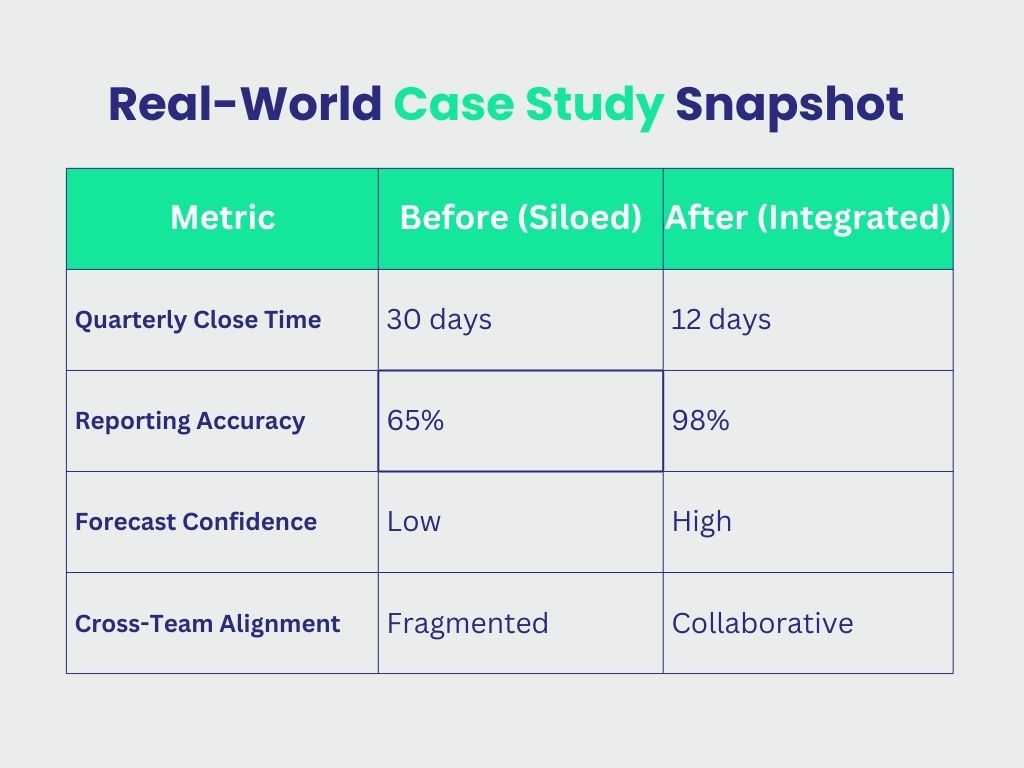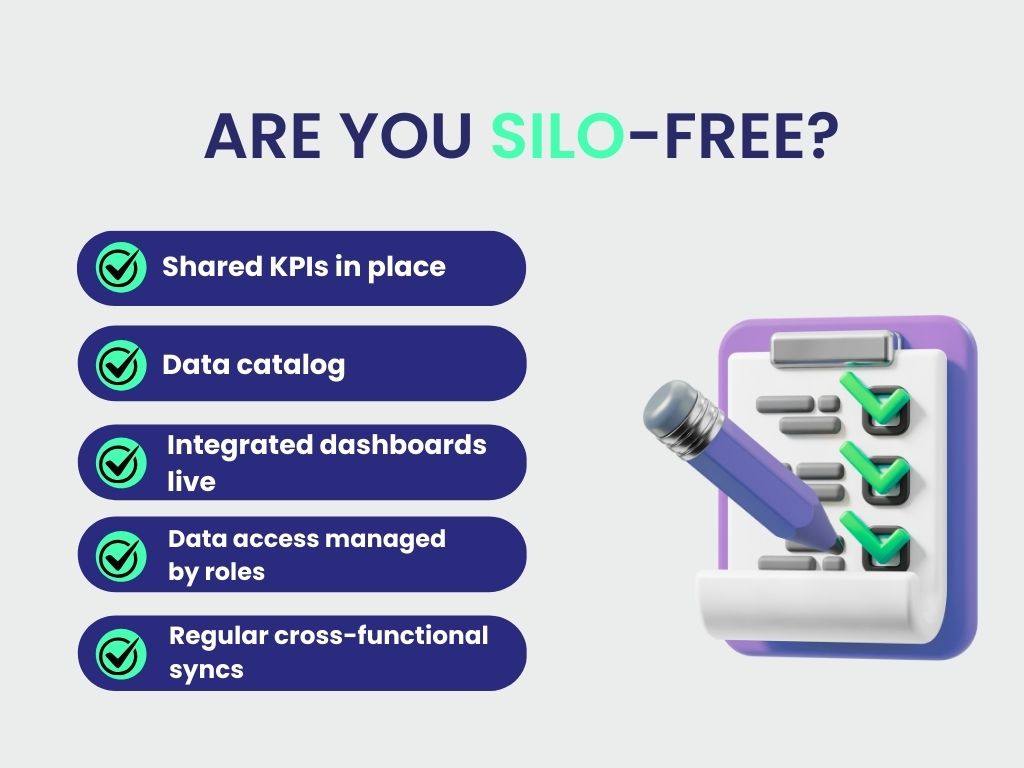Let’s be honest, most businesses are sitting on a goldmine of data, but hardly anyone’s tapping into it properly. Why? Because the information is stuck in silos, buried in separate systems, spread across departments, and locked behind outdated tools.
These data silos slow down your teams, create confusion, and ultimately cost you time and money. And the worst part? Most organizations don’t even realize how much they’re losing because of them.
Breaking down data silos isn’t just a nice-to-have, it’s a mission-critical move for businesses that want to compete, grow, and innovate in today’s data-driven world. This blog dives deep into the root causes, real impacts, and transformative potential of eliminating data silos across your organization.
What Are Data Silos?
Imagine each department in your company as its own island. Marketing, finance, sales, customer support—they all collect and store data, but rarely share it across teams. That’s what a data silo looks like.
Instead of one unified system, you end up with:
- Marketing’s data in HubSpot
- Sales in Salesforce
- Finance in spreadsheets
- Operations using their own tools
Everyone’s working hard, but no one’s seeing the full picture. And that fragmentation makes it impossible to optimize outcomes across the business.
Data silos tend to form from:
- Disconnected apps and platforms
- Conflicting departmental priorities
- Legacy systems that resist integration
- Poor communication and collaboration
- Security concerns or regulatory over-caution
Over time, these barriers create layers of dysfunction that hinder productivity, accuracy, and innovation.
Why Do Data Silos Exist?
Data silos rarely happen because of one bad decision—they accumulate over time. Here’s why they persist:
1. Departmental Ownership & Politics
Data often becomes territory. Teams may resist sharing because it feels like losing control—or power. Without strong interdepartmental alignment, data hoarding becomes the norm.
2. Fragmented Tool Adoption
Modern businesses adopt tools at lightning speed. But with every new CRM, BI dashboard, or analytics platform comes the risk of further segmentation.
3. Lack of Enterprise-Wide Data Strategy
Without a clear roadmap for data strategy integration, teams operate in silos by default. Strategy is what binds systems together.
4. Resistance to Change
People are creatures of habit. Even when better solutions exist, employees often default to what they know—especially if they weren’t part of the buying or integration decision.
5. Fear of Exposure or Accountability
Sometimes, silos are unintentionally reinforced to avoid revealing gaps in performance, errors in reporting, or compliance oversights.
Understanding these drivers is key to changing not just your tools, but your culture.
The True Cost of Data Silos
Silos don’t just slow you down—they silently sabotage performance across every layer of the organization.
Time Drain
Teams spend hours hunting down information, duplicating reports, and manually cleaning data. Multiply that across departments, and it’s a hidden productivity sink.
Decision Paralysis
Inconsistent or incomplete data makes it hard for leaders to act. You’re left debating metrics instead of executing strategy.
Missed Opportunities
Marketing doesn’t know what sales converted. Sales can’t forecast based on finance. Support doesn’t know the customer journey. In the end, you lose the ability to capitalize on cross-functional insights.
Damaged Trust
If every team is working from a different source of truth, trust erodes. Collaboration turns into finger-pointing.
Financial Waste
Investments in analytics, AI, or digital transformation initiatives fall flat if your data foundation is fractured.
Eliminating silos is a high-leverage move that directly impacts operational agility, revenue, and innovation potential.
How to Start Breaking Down Silos at Work
Dismantling data silos isn’t about a single silver bullet—it’s about stacking smart habits, tools, and leadership decisions over time. Here’s your blueprint:
1. Launch a Cross-Functional Data Council
Form a task force with stakeholders from every major department. Give them a mandate: define shared goals, align metrics, and prioritize integrations.
2. Inventory All Systems and Data Flows
Map out every platform, dashboard, and data source your teams use. Identify duplication, disconnects, and redundancies.
3. Implement a Unified Data Infrastructure
Adopt a central data platform (e.g., Snowflake, BigQuery, Redshift) and integrate tools using middleware, APIs, or ETL solutions. Standardize storage, access, and schema practices.
4. Adopt Shared KPIs and Reporting
Create universal definitions of key business terms—”lead,” “customer churn,” “net revenue.” Push these shared metrics into every team’s dashboard.
5. Build Role-Based Access, Not Walls
Use identity and access management systems to share data securely across teams. Empower without compromising compliance.
6. Train for Data Literacy
Provide ongoing education so every team—from HR to engineering—understands how to read, question, and act on data.
7. Showcase Cross-Team Wins
Celebrate when teams break down barriers. Publish internal case studies, share metrics, and reward collaboration.
Real-World Story: Fixing Financial Data Silos
A multi-national retail chain had regional finance teams operating in silos: spreadsheets in Asia, ERPs in Europe, and third-party tools in North America. Quarterly closes were late. Forecasts were wildly off. Trust in numbers was at an all-time low.
They partnered with a data integration firm to build a single financial data warehouse in the cloud. They:
- Automated ingestion from 12+ source systems
- Created a real-time dashboard for CFOs and controllers
- Standardized financial terms and formats globally
Results:
- 60% faster reporting
- More accurate scenario planning
- Board-level confidence in strategy execution
This is what breaking down a financial data silo looks like in action.
What Happens When You Eliminate Data Silos
The benefits of tearing down data walls ripple across every business unit:
Connected Culture
Data becomes a shared language, not a guarded secret. Collaboration replaces confusion.
Speed to Insights
Integrated systems mean faster access to data—and faster execution.
End-to-End Visibility
Leaders and teams can finally see the entire customer lifecycle, supply chain, or product pipeline in one view.
AI & Automation Readiness
You can’t run intelligent systems on broken data. Clean, connected data enables AI, predictive analytics, and advanced automation.
Melhoria Contínua
Shared data reveals weak points. It feeds experimentation and iteration. It drives real-time learning.
How to Know You’re Making Progress
Look for these key signals:
- Data is used across departments—not just consumed within them
- Dashboards use standardized KPIs
- Teams ask for integrations, not tools
- “Where’s that data?” becomes “Here’s the report”
- Time-to-insight is shrinking quarter over quarter
Use these indicators to benchmark your journey toward a truly data-driven culture.
Final Thoughts: Breaking Silos is the Foundation for Growth
Data silos aren’t just a technical glitch—they’re a strategic liability. If left unchecked, they undermine growth, waste resources, and stifle innovation.
But once you eliminate data silos, your organization unlocks something powerful: clarity, agility, and alignment.
And in a world where change happens fast and decisions need to be smarter, that’s the edge you can’t afford to miss.
SymuFolk helps teams go from fragmented to connected, from reactive to strategic. If you’re ready to unify your systems and your people—let’s start building together.










